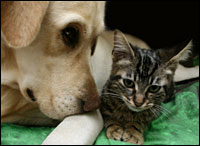 Without pets, the world would be such a pale, less playful version of itself. No Wallace and Gromit videos. No Fluffy purring in our laps or Fido fetching his Frisbee. No cheerful creatures welcoming us home and adoring us unconditionally. (OK, we’d still have mom.)
Without pets, the world would be such a pale, less playful version of itself. No Wallace and Gromit videos. No Fluffy purring in our laps or Fido fetching his Frisbee. No cheerful creatures welcoming us home and adoring us unconditionally. (OK, we’d still have mom.)
So we love them, there’s no getting around it. But can we lighten the eco-pawprint of our pets? Why yes, we can: today’s marketplace offers everything from eco-friendly kibbles, collars, and chew toys to beds, leashes, and kitty litter — all of which promote better pet health without hurting the planet. If you’re less inclined toward consumption, we still have ideas for greening your goldfish bowl (and a handy list of resources, too).
Here’s how to start.
Level One: The Baby Steps
Spay it forward. More than 50,000 cats and dogs and untold numbers of other animals are born every day in the U.S., an overpopulation crisis that takes a major toll on the planet. Outdoor cats kill huge numbers of songbirds; feral or unleashed dogs harass and kill other wildlife; and surplus pets in general spread disease and foul the landscape with their waste. Life is no picnic for the unwanted, either: an estimated 3 to 4 million of them are euthanized at animal shelters each year. So snip this population crisis in the bud — literally — and spay or neuter all your pets, including those repro-crazed rabbits. They’ll live healthier, longer lives as a result.
Don’t spend bills at mills. Huge numbers of pet stores and other retailers get their animals from puppy mills, the notorious mass-breeding outfits that spark over-pup-ulation and produce sick, badly bred animals. The best way to muzzle the mills, not surprisingly, is to boycott them. So pick a pooch from a shelter or animal rescue group instead. Online resources like Petfinder or Pets 911 can help you find the right match.
Level Two: The Next Steps
Keep it simple. Choose toys and tidbits made and packaged with recycled, organic, or earth-friendly materials (hemp doggy Frisbees and leashes, anyone?). Rejoice in the growing variety of natural pet shampoos, potions, and flea and tick products, which are free of organophosphate insecticides.
Nix the vinyl and nylon. Spot doesn’t need that raincoat with matching collar and leash, and the atmosphere doesn’t need the nasties that result from vinyl production and disposal. If every pet toy sold each year were made of 100 percent recycled materials, according to The Green Book, it would save enough virgin materials to make a Frisbee more than two miles in diameter. Fetch!
Doo the right thing. Pet poop isn’t our idea of a fun topic, either, so we’ll cut to the chase. 1) Pick up the dog turds. If you don’t, rain can sweep them into storm sewers and local waterways, spreading pollution as they, um, go. 2) Use biodegradable bags. Putting poo in regular plastic bags only preserves it at local landfills for the next century. 3) Avoid kitty litters made with clay, a material that’s (ugh) strip-mined. Clay litters can also include silica dust and clumping agents, which have been linked to feline lung diseases and other health problems. Take the safer route and use eco-friendly alternatives like Feline Pine, Yesterday’s News, or others.
Level Three: The Next Step
Go organic. Conventional pet foods come with ingredients you may not have bargained for, including pesticides, herbicides, hormones, antibiotics, and — last year’s addition — melamine, a contaminant that killed 1,950 dogs and 2,200 cats and sparked one of the biggest pet food recalls in history. (Note to vegans or the easily nauseated: you might want to skip the next sentences.) These mainstream brands often also include items coyly described on their labels as “meat or poultry byproducts” or “reconstituted animal byproducts” — industry-speak for grisly waste materials (hair, blood, and worse) culled from “4D” animals: the dead, diseased, dying, or disabled.
As with human food, buying organic can strain the pocketbook: a 15-pound bag of certified organic cat or dog food can cost $50. If you don’t want to go that route, consider making your own kibbles and bits. It takes time, precision, and consultation with your vet to make sure you’re providing the proper vitamins, minerals, supplements, and meats — after all, carnivores do need carni. But there are dozens of books, lists, and websites to help guide you, and you’ll have the satisfaction of being in charge. Bone appetit!
Resources
Get a new leash on life with our list of handy — or should we say pawsy — resources. And add your own suggestions and ideas in the comments section below.
Spaying guidance
Humane Society of the U.S.
Spay USA
Green pet products
Only Natural Pet
Worldwise
Earth Dog
Urban Leash and Treat
Biodegradable waste bags
Eco-Products BioBags
Poopbags
Organic pet foods
Organics 4 Your Pets
Natura Pet Products
Heidi’s Homemade
Newman’s Own Organics Premium Pet Food
Castor & Pollux Pet Works


